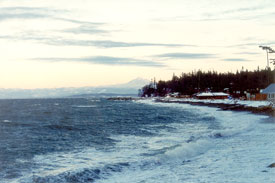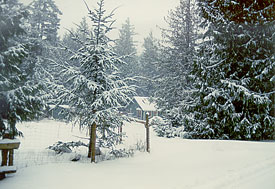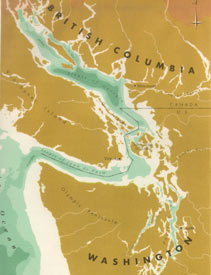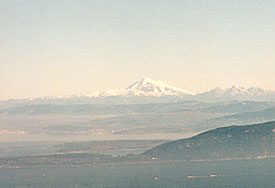|
Learning about our Bioregion helped me understand
the dynamics of our Maritime Climate.
Understanding weather patterns is an essential
tool for successful gardening. In the mid-1990's, when I moved from Oregon
to northwestern Washington, I felt surprisingly unsure of myself when
I began my first gardens. I no longer had the inner knowing that I had
relied upon to make some of the most basic choices for plant placement.
It took awhile to accept that my physical "uprooting" had
a psychological component to it—and that it would take time and experience to
find my way of knowing again.
Many people who fall in love with these islands, do so in the summer
months. When they move here, they find a big surprise when the weather
changes. We arrived in the early fall and before long, we started to
notice a significant decrease in daylight. Mornings and late afternoons
were becoming dark as night. Each day, the sun descended on the horizon
until it finally disappeared behind an unobtrusive hill to the south
of us.
 The cedar forest surrounding our house seemed to loom larger and
enclose us. I could see plant life shifting and preparing for winter,
but I, this "human
plant", who
was born and raised in Oregon, hadn't adapted yet. Rather, the change
in light had signaled symptoms of light deprivation and a clear message
to my psyche that I was not home. The cedar forest surrounding our house seemed to loom larger and
enclose us. I could see plant life shifting and preparing for winter,
but I, this "human
plant", who
was born and raised in Oregon, hadn't adapted yet. Rather, the change
in light had signaled symptoms of light deprivation and a clear message
to my psyche that I was not home.
Winter came, bringing bitterly cold
arctic winds. These "Nor-easters",
come down through the Fraiser River Valley in
British Columbia, Canada, and blow particularly hard on the northern
side of the island where we were living. That December, a record 100
year snow storm covered us with about four feet of snow. The roads could
not be cleared and we were house-bound for more than a week.
 The quiet
of the island and the gentle snowfall
on the cedar trees, made time slow down. I relaxed and watched as birds
foraged on seed heads from plants that I had neglected to prune. Seeing
their value under these severe conditions, gave me an inner resolve
to be more inclusive in my gardening practices. The quiet
of the island and the gentle snowfall
on the cedar trees, made time slow down. I relaxed and watched as birds
foraged on seed heads from plants that I had neglected to prune. Seeing
their value under these severe conditions, gave me an inner resolve
to be more inclusive in my gardening practices.
When the island thawed, grocery store conversations
were filled with stories of storms from years past. I gathered bits of
information here and there and without consciously knowing its importance
for me, began weaving together the pieces of the "weather
puzzle".
When spring arrived, I noticed
that our neighborhood was a lot colder than the nearby village, where
flowers were already blooming and people had cast off their winter
hats and scarves. My
green thumb was eager to start planting but my ground was still frozen.
I had not realized that our part of the island had a distinct micro-climate.
In fact, the combination of rolling hills, forest lands, small valleys,
and inlet bays, creates a variety of microclimates such that no place
is really like another.
Experiencing the island's abundance and diversity
started to break up a "knowing" within me that was rooted in a more "homogenized"
landscape where the "wild" is no longer alive. The mystery
of how nature works was gradually unfolding, teaching
me to make the deep inner connections necessary for me to integrate
and ground myself.
Learning About Our Climate
Over the next three years, I experimented with a small scale
vegetable garden and remodeled the flower beds around our house.
At the same time, I actively learned as much as I could about the geography
of our area and how it effected our weather patterns. Workshops on island
stewardship, training as a marine naturalist, native plant and geology
field trips, and garden club meetings all strengthened my foundation.
 I
learned that Orcas Island is one of over 200 islands (depending on the
tide), that makes up the San Juan Islands, an archipelago that stretches
across the Salish Inland Sea. This inland waterway sits in the heart
of the convergence of three huge basins carved out by the Vashon Glaciation,
10,000 years ago. To the north is Canada's Georgia Straight in British
Columbia, to the south is Washington's Puget Sound, and to the southwest
is the Strait of Juan de Fuca, which is divided by both countries. I
learned that Orcas Island is one of over 200 islands (depending on the
tide), that makes up the San Juan Islands, an archipelago that stretches
across the Salish Inland Sea. This inland waterway sits in the heart
of the convergence of three huge basins carved out by the Vashon Glaciation,
10,000 years ago. To the north is Canada's Georgia Straight in British
Columbia, to the south is Washington's Puget Sound, and to the southwest
is the Strait of Juan de Fuca, which is divided by both countries.
The Cascade
mountain range, which extends from British Columbia into southern Oregon,
creates a boundary between the continental weather systems on its eastern
side and the winds
from the Pacific Ocean, which bring cool, moist air inland. The interaction
of these weather systems results in the characteristic
weather patterns of our "Maritime Northwest Climate". These
dynamics of weather and geography also define
our aptly named, Cascadia Bioregion.
 In
1998-1999,
Mt. Baker, the highest Cascade mountain peak near us, recorded the highest
level of snowfall in the world. It broke the record held by Mt. Rainier,
another peak in the Cascades, 150 miles to the south. Our island temperatures,
however, are usually above freezing, so snow seldom stays on the ground
for more than a few days. (Except in 100 year snow storms!) In
1998-1999,
Mt. Baker, the highest Cascade mountain peak near us, recorded the highest
level of snowfall in the world. It broke the record held by Mt. Rainier,
another peak in the Cascades, 150 miles to the south. Our island temperatures,
however, are usually above freezing, so snow seldom stays on the ground
for more than a few days. (Except in 100 year snow storms!)
There are seven climate zones in the "Maritime Northwest". We live
in the Olympic Rainshadow Zone, or "Banana Belt". This
crescent shaped area is protected from rainstorms by mountain ranges
on Vancouver Island, the Cascade mountains, and the Olympic Mountains
on Washington's Olympic Peninsula. These surrounding mountains give us
less than 30 inches per year. Most places west of the Cascades receive
more than 30 inches of rain a year, while some westward slopes of the
Olympic and Cascade mountain ranges receive more than 200 inches a year.
Our climate is mild throughout the year which allows for an extended
growing season, so winter gardening is a definite possibility for cold-hardy
crops. Springs are wet and the soil temperature does not warm up until
the middle of May or early June. Our summers are dry and often
drought-like. However, they may also be cool and foggy,
as cold air moves in from the Strait of Juan de Fuca. Our very
cool evenings and the low heat accumulation over the summer makes it
hard to grow heat loving plants like tomatoes and melons.
The Dragonfly Garden Micro-climate
After living on the northern side of the island for three years, I
felt ready to exercise my "island awareness", and find a sunnier
location to live and garden. We made a list of what we really wanted
and before long we were introduced to three acres of forested land with
a large open meadow that extended down to a nearby harbor. We knew an
open meadow with full exposure to sunlight was a rarity on the island,
so there was no question that we had found the ideal place for our dream
garden. The acreage was located in the warmest area of the island, or
the "Mediterranean" as
islanders call it.
We began landscaping around the house, and I started a little vegetable
garden in a small wooded clearing. Once again, there
were valuable things to learn about the weather in our new location.
We were located on a small peninsula, which adds to the amount of sea
salt we receive from rainfall. I began to understand the importance of
sweetening the acidic soil with a yearly application of lime. I got to
know the winds, the drainage of the land, the path of the sun, the native
plants, the migration of birds, and the community of
living creatures. Three years later we were ready to
till the big meadow and begin the Dragonfly Garden.
Today, we live with concerns about scarcity of water and summer
droughts. No one is sure about the source of our water supply. Some think
it is Mt. Baker. Our geology is so complex that finding
water for a well is challenging. We are lucky to have a good well
and good tasting water. We water conscientiously.
Rainwater catchment
is a project in the future for the garden. With the advent of Global
Warming, we are continually educating ourselves in order to best adapt
to the possible changes. Recent analysis has shown that spring is arriving
earlier in the western United States, particularly in the Pacific Northwest.
(See climate
change in our bioregion).
We are blessed with an abundance of topsoil,
which is a foot and a half deep in one corner of the garden. The
last glaciation scraped off most of the topsoil on the island and
people struggle to garden in rocky ground. When people come to visit
the garden, they often comment on our ideal conditions, as if surprised
to see a spot like this on the island. We agree, knowing how fortunate
we are to be able to garden and make our home here.
If you are a cloud lover, you many be interested in my father's website
Cloudman.com
Sunset Photograph by Linda Henry
| -jr6.jpg)
